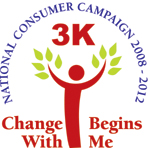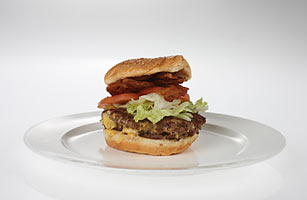| Fast Food: Would You Like 1,000 Calories with That? |
 |
 |
 |
| Written by 3K Admin |
| Monday, 22 June 2009 09:39 |
|
By Sean Gregory Monday, Jun. 29, 2009 How sloppy is that triple Whopper with cheese? It has 1,250 calories, or 62.5% of the recommended 2,000-calories-per-day diet. The Fried Macaroni and Cheese from the Cheesecake Factory? Try 1,570 calories — according to health experts, you're better off eating a stick of butter. If public-health advocates, and now the Senate, get their way, when you look at a menu from a chain restaurant, those calorie counts will be staring you down. "Order me if you dare," the mighty Quesadilla Burger from Applebee's (1,440 calories) may entreat. Spurred by the passage of a slew of state and local menu-labeling laws, on June 10 the Senate reached a bipartisan agreement to include a federal menu-labeling law as part of comprehensive health-care reform. Of course, who knows when that hornet's nest will come up for a vote. But in the meantime, health proponents are likening the Senate provision to legal requirements for a clothing label — i.e., what it's made of. "Isn't information that can help you avoid obesity and diabetes as important as knowing how to wash your blouse?" says Margot Wootan, director of nutrition policy for the nonpartisan Center for Science in the Public Interest.(See how many calories are in Dunkin' Donuts Sausage, Supreme Omelet & Cheese on Bagel.) Until recently, the restaurant industry had been pushing a federal bill that would require chains with 20 or more restaurants nationwide to post calorie information somewhere near the point of purchase but not on the menu itself. The industry claimed menu postings would be a costly logistical burden and would clutter valuable real estate on the menus. Not surprisingly, chains won't voice the most obvious argument against high-profile calorie counts. "They're concerned that consumers will be turned off by what they see," says Tom Forte, restaurant analyst at the Telsey Advisory Group, a consulting firm. In the end, the industry backed the Senate's on-the-menu provision in an effort to pre-empt a patchwork of state and local statutes (13 have passed, and 30 or so more have been introduced). Such legislation would prevent a municipality from requiring both calories and, say, saturated fat to be tallied on menus. (The fried macaroni and cheese at the Cheesecake Factory has a staggering 69 grams of saturated fat — more than you should eat in 3½ days.) As the menu-labeling momentum keeps surging, will such policy really improve eating habits? Well, it can do no worse than what's out there. In a study published in the May issue of the American Journal of Public Health, researchers observed 4,311 patrons of McDonald's, Burger King, Starbucks and Au Bon Pain to see if they accessed in-store nutrition data. The info was not on the menu board but in a pamphlet, on a wall poster or an on-site computer. Only six, or 0.1%, of the patrons looked at the numbers. Sure, a few more may have already studied the information. But six out of 4,311? If restaurants are sincere about health, they need to put calorie counts on the menu, straight in the customers' sight lines. So far, mandatory on-the-menu calorie counts have been implemented in only three localities: Washington's King County (which includes Seattle), New York City and Westchester County, a suburb of New York. And since none of these provisions have been in place for more than a year, nutritionists have yet to gather empirical proof that they work. But some science suggests that prominently displayed calorie counts steer purchases. In 2007, researchers in New York City examined consumer eating habits at Subway, which voluntarily posted calorie info in its stores. This study, also published in the American Journal of Public Health, reported that Subway patrons who pondered the calorie information purchased 52 fewer calories than those who didn't. Further, according to a survey conducted in February by Technomic, a food-industry consultancy, 82% of New York City residents said the new highly visible nutrition information has affected their ordering. Of those people, 71% said they sought out lower-calorie options, and 51% said they no longer ordered certain items. While such statistics are promising, menu counts are no silver bullet. Martin Lindstrom, the noted consumer psychologist and author of Buyology: Truths and Lies About Why We Buy, fears that consumers will tune out the numbers long term. "Eventually, calorie counts will just be wallpaper," he says. But forced disclosure could lead more restaurants to change their offerings. A report by New York City health officials noted that since menu-labeling went into effect last summer, some chains have lowered the calorie counts on certain items. For example, in March 2007, a Chicken Club sandwich at Wendy's was listed as being 650 calories. In June 2008, as the New York law kicked in, the item was 540 calories — a 17% drop. (Wendy's used a lower-calorie mayo to reduce the count, but a spokesman insists menu-labeling played no part in the move. Call it a happy coincidence.) Meanwhile, Yum! Brands, parent company of Kentucky Fried Chicken, Pizza Hut and Taco Bell, has promised to post calorie information on its menus by January 2011. If the creator of KFC's Famous Bowls — fried chicken, mashed potatoes, corn, gravy and shredded cheese packed together for your gut-busting pleasure — volunteers to share these numbers, what excuse can other chains claim for not following suit, particularly if Washington lags in forcing them to do so? The writing is on the wall. And perhaps, as a result, fewer calories will be in your stomach. |
| Last Updated on Monday, 22 June 2009 12:58 |


